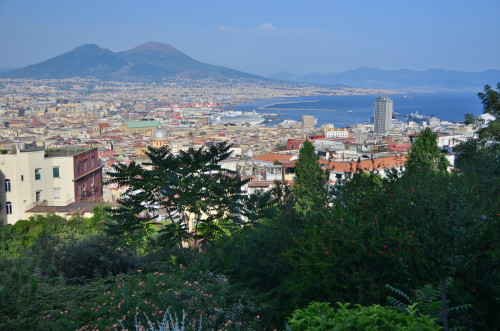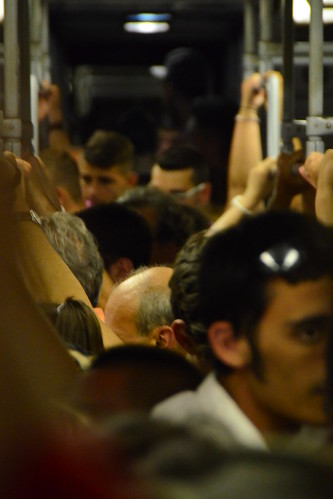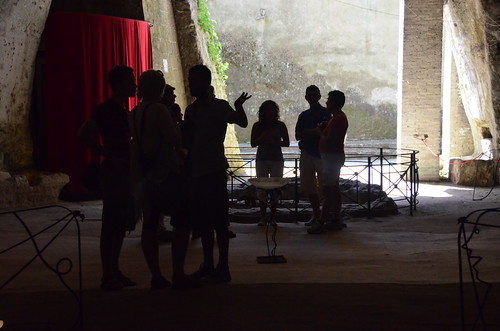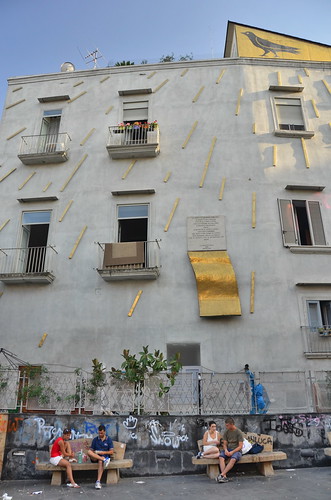
“Naples,” the young man I met warned me, “is extremely dangerous. The Mafia is there, but if you don’t encounter them, someone will surely try to take your camera or your money.”
Of course, this young man had never been to Naples. And even if he had — and even if Naples was the most dangerous place in the world — I knew someone in Naples. Well, not just someone. Someone who, the extent to which he is smart and charming not withstanding, has lived in Naples his whole life.
Francesco, whom I met last year in Barcelona, shrugged off my worries. “To start with,” he said, “the Mafia is in Sicily. But even there, they wouldn’t be concerned with tourists like you.”
Worries about the Mafia were the furthest thing from my mind as I explored Naples, a city I would never, ever use the word “dangerous” to describe.
A panorama of Naples, with Mt. Vesuvius in the background

Naples was bathed in bright sunshine as my train from Milan pulled into its central station, a glittering city mixing ancient and modern, with Mt. Vesuvius towering in the background. That Naples was huge and rich and vibrant was evident to me before I even met Francesco in the station.

Naples’ public transportation infrastructure ranges from amazing to archaic
“This train,” Francesco explained to me after we’d showered at his place and were on our way back to Naples’ ancient Centro Historico, “used to be on time. Now, we have to wait 40 minutes or even more to take it. It’s created a cycle: People don’t feel that they need to pay to take a train that’s so late; fewer frequencies run; it gets more crowded; fewer people pay; and so forth.”

Chaos and calm are effortlessly juxtaposed in Naples
If my photo of the train’s interior has even moderately conveyed how hot and crowded it was, you can imagine how open and spacious the walkways of Naples’ historical center, which has been inhabited as far back as Roman times, seemed to be. Naples, I would rapidly learn, is a city of contrasts more dramatic than almost anywhere in the world I’ve visited.

Architecturally, Naples makes even Florence look lame
Francesco is not only sweet and hospitable, but also happens to be an architect. He was the perfect person to have alongside me as I explored Naples’ chaotic center, which is home to buildings that span the city’s entire 2,500-year history. As you can see in this shot, domed Renaissance-era churches exist side-by-side Gothic cathedrals, 19th century residential buildings and modern skyscrapers.

The story of Fontanelle Cemetery is even grislier than this picture suggests
Architecture isn’t the only thing about Naples that’s disparate. In spite of Naples’ strong Catholic heritage, paganism has a central place in the city’s culture. The Fontanelle Cemetery, located in the Materdei neighborhood, illustrates this well.
Fontanelle Cemetery was originally intended as a receptacle for “old” bones in the Spanish colonial period of Naples, during which there was a cemetery shortage of sorts. The cavern — which was formed, like thousands of others in the city, because the soft limestone inside is a great building material — subsequently became a popular resting place, after epidemics like the Great Plague of 1656 and the cholera outbreak of 1837.
Fontanelle Cemetery has its origins as a Christian burial site, but severe flooding in the 19th century washed the remains out onto Naples’ streets, leaving the priest who tended over the remains to replace them haphazardly. This is where paganism comes in: During the years that followed, members of a so-called “cult” of Neapolitan citizens would “adopt” certain bones, presumably for good luck.

Naples’ catacombs are less touristy than Rome’s, but tell just as interesting a story
The story behind another Naples burial site, the city’s “catacombs,” is equally rich. The Catacombes di San Gennaro are even older than Fontanelle Cemetery, having been inaugurated in the second or third century as a pre-Christian burial site.
The catacombs of Naples are less famous than those of Rome, in part because Christians were never persecuted in Naples. The Naples catacombs have nonetheless fallen victim to severe looting over the years, including the theft of the remains of namesake Saint Gennaro, who was at one point interred there.
If you do visit the catacombs, study some Italian beforehand. Although Francesco was nice enough to translate for me, the British tourists in our group had to mostly guess.

In Naples, religion and art effortlessly intermingle with daily life
Although I was bombarded by Christianity (and, worse, Christians) when I visited Rome five years ago, Catholicism in Naples seems much more present from a visual standpoint than as a conspicuous part of culture, at least for foreign visitors. The extent to which religion and art intersect with the gritty streets of Naples almost makes me want to say an “Our Father” or “Hail Mary”!

The interiors and exteriors of Naples’ proper Metro stations have all been designed by prominent artists
Of course, not all art is religious in Naples. Just as the city is an architectural pastiche of the two-plus millennia of history that have occurred here, so too is there an abundance of modern art in the city.
Naples’ Metro system (not to be confused with the old urban rail lines I mentioned earlier) are the shining example of this phenomenon. The interior and exterior of each station feature designs by prominent international artists, which are not only nice to look at, but have actually revitalized whole sections of Naples.
I could go on about how much I love Naples for days. I’m sad to leave Naples not only because I love the city so much, but more importantly because I love my dear friend Francesco, who is as significant a part of Naples to me as the buildings, the art and Mt. Vesuvius itself.
I’ll end by recounting the conversation he and I had before I arrived.
“I’ve booked a week in Naples,” I remember saying. “Do you think that’s enough?”
He laughed. “A year is not enough to see everything in Naples. But yes, I suppose a week will do.”

Robert Schrader is a travel writer and photographer who’s been roaming the world independently since 2005, writing for publications such as “CNNGo” and “Shanghaiist” along the way. His blog, Leave Your Daily Hell, provides a mix of travel advice, destination guides and personal essays covering the more esoteric aspects of life as a traveler.








